Don't wanna be here? Send us removal request.
Text
Social Media within China: 8
Social media, a seemingly normal part of most the worlds life, is heavily regulated in China. China, due to the nature of which the government operates requires social rest within the country. The communist country has created the most sophisticated firewall in the world to monitor and block unwanted internet traffic and non-complying sites. This is informally known as ‘The Great Firewall of China’. China has created such processes in hope of protecting the country’s political and economic interests, which is predominantly undermined by journalists. It has been noted that China has the most arrests in world due to netizens associating themselves with outsiders and anti-corruption movements (Wiki, 2017). Seems suspicious more than anything in my opinion. The firewall mainly blocks western social media sites which are loaded with freedom of speech and dangerous opinions.
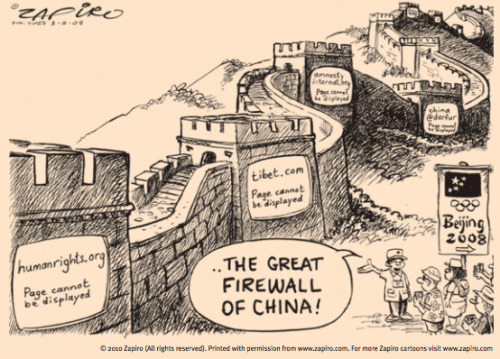
Not surprisingly, digital citizens have come up with ways to avoid the firewall cleverly but simply. For instance, many technical ways have been established such as diverting your internet traffic through other countries by using tools such as VPN’s (Bischoff, 2014). Unfortunately, the firewall has somewhat learned to identify traffic from VPN’s and then destroy the connections. Another less technical way used cleverly by local protesters or activists is to use code words on Chinese created social media sites. Phrases such as ‘Naked Officials’ (裸官 luǒgu��n) are used which describe the event that government officials are sending public sourced funds overseas to family or acquaintances of corruption (Lou, 2015).

It is important that internet users bypass the firewall and use the internet as a means to communicate due to the sheer size of digital citizens and users in China. China has more than double the internet users of America, who places second in the number of internet users (Chiu et Al, 2012). China utilises copycat apps with similar affordances as western apps such as QQ, WECHAT, MOMO, Sina Weibo and RenRen which is a copy of Facebook (Gentlemen in China, 2016). Utilising these apps to create publics that have an aim of addressing the corruption in China could prove advantageous in the future when they are of a significant size and generate power.

In conclusion, from previous and current research I can assume that China has a growing power that lies with the people. The people need ways to penetrate China’s advanced yet arguably unfair internet filtering system. In the future, we can only hope that activist with causes become free to fight against any injustices within the country. Note: This piece was written with no intention to offend anyone who may be sensitive to the information provided.
References:
Wiki 2017, ‘Internet Censorship in China’, Wikipedia, Viewed on 19 May 2017 <https://en.wikipedia.org/wiki/Internet_censorship_in_China>
Bischoff, P. 2014, ‘Five Ways to Sneak through China’s Firewall’, Tech in Asia, Viewed on 19 May 2017 <https://www.techinasia.com/5-ways-sneak-chinas-great-firewall>
Luo, I. 2015, ’20 Ingenious Code Words Chinese Netizens Use to Skirt Censors’, The Epoch Times, Viewed on 19 May 2017 <http://www.theepochtimes.com/n3/1711255-20-ingenious-code-words-chinese-netizens-use-to-skirt-censors/>
Chiu, C. 2012, ‘China’s Social Media Boom’, Mckinsey & Company, Viewed on 18 May 2017 <https://ilearn.swin.edu.au/bbcswebdav/pid-6273096-dt-content-rid-34296541_2/courses/2017-HS1-MDA20009-220271/McKinsey-Chinas-Social-Media-Boom1_2012.pdf>
Gentlemen in China 2016, ‘8 Social Media Apps to Master in China’, Marketing to China, Viewed on 18 May 2017 <http://marketingtochina.com/8-social-media-apps-to-master-in-china/>
0 notes
Text
Effects of Social Gaming on Gambling: 7
Gaming today has evolved due to societies tremendous technological advancements, although the definition on ‘playing’ can still be utilised in outlining the general definition of participating in a game, or playing. To play is to act outside of life’s ordinary boundaries, in a non-serious yet intense and consuming activity which is based on fixed rules and in a certain setting. The act is usually correlated with the formation of social groups.
Gaming can be outlined in 4 sub categories:
Agon; a type of gaming which is competitive such as the “8 Ball Pool” app.
Alea; which is a type of gaming which is based on chance, such as Sportsbet.
Stimulation; a type of gaming where a person becomes a fictional character to remove himself from the real world
Vertigo; which is based, as explained by the name, by moving things or disorientation such as Battlefield 1.
Gaming in the past few years has become extremely social, where before, only online prohibited console and computer games where able to access online databases. This is arguably a problem when it comes to gambling, or participating in alea. Showing describes the problem where the media enables most of the public to witness gambling adverts. due to the susceptibility to manipulation of the public, the media and social advertising can lure in more and more Australians into Gambling. On average in 2014, an adult lost $1,247 on gambling per year which is the highest out of all countries (Macduling, 2015). Over 80% of Australians Adults gamble and due to recent online accessibility and trends, this is expected to increase (Wiki, 2017). About 8% of Australians gamble interactively, or online, which has increased from only 1% in 1999 (AIFS, 2017). Just mobile betting expenditure throughout Australia has increased from 1 billion in 2006 to 12 Billion this year.
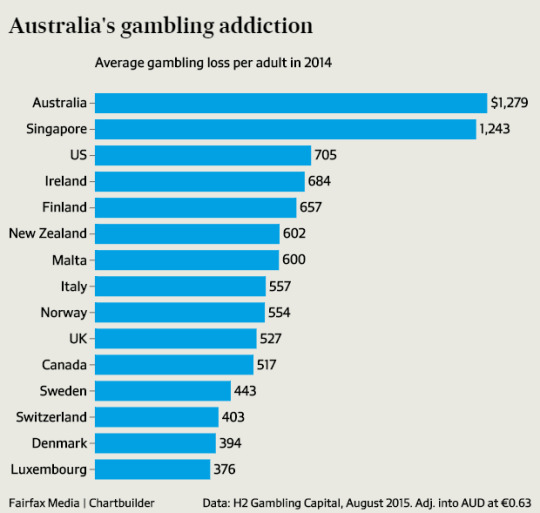
Understandably, Australians are entitled to interact with whichever online communities they please. Unfortunately though, many new gambling publics are being created, for example Poker Stars Facebook page. This allows for a collection of regular participants to encourage each other further through competitiveness or other pressures. Not that I am against gambling, but do gamble in moderation if you have to.
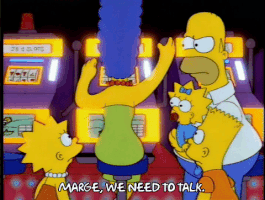
Arguments appear where video gaming can also lead to gambling due to the nature of each types of playing which causes social anxiety. Although, research is unclear on this and predominantly suggests that there is no link or the research was not conducted appropriately to come to a conclusion (Forrest et al., 2015).
References:
McDuling, J 2015, ‘Australia’s Gambling Obsession, in One Depressing Chart’,The Sydney Morning Herald, Viewed on 18 May 2017 <http://www.smh.com.au/business/the-economy/australias-gambling-obsession-in-one-depressing-chart-20150901-gjd2w1.html>
Wikipedia 2017, ‘Gambling in Australia’, Wikipedia, Viewed 18 May 2017 <https://en.wikipedia.org/wiki/Gambling_in_Australia>
AIFS, 2017, ‘Interactive Gambling’, Australian Institute of Family Studies, Viewed on 18 May 2017 <https://aifs.gov.au/agrc/publications/interactive-gambling/export>
Forrest, CJ, King, DL & Delfabbro, PH 2015, 'The gambling preferences and behaviours of a community sample of Australian regular video game players', Journal of Gambling Studies, Viewed 18 May 2017 < https://www.responsiblegambling.vic.gov.au/information-and-resources/research/giro-research-updates/june-2015/video-gaming-and-gambling-linked-or-not>
0 notes
Text
Public Health Campaigns and Social Media: 6
Social media is a platform used by many, for many. In recent times as social media use is on the rise, the more organisations and industries intend to capitalise this opportunity. Public Health campaigns being one of them, are basically awareness campaigns which hurls statistics to its viewers to leave an impression. The goal of health campaigns are to raise awareness which effectively raises funds for the said issue in hope of a solution.

Research suggests that over 80% of people use the internet to source health information, such as symptoms, causes and diagnoses (Weaver, 2016). The internet can be seen as a mediator, for instance WebMD is an online tool used by the public to seek medical advice from professionals over the internet. As such a large portion of the population use the internet to find information, health campaign leaders took the first step in providing information to highlight a cause which was deemed important to them, and most likely the public. These campaigns can be started by large organisations or any individual which has access to social media. That is the advantage of using social media, not only does it reach millions but it can also be cost effective.
Social media has been in the spotlight recently when dealing with Mental illness. For example, #ITSOKAYTOTALK was started by a UK rugby player whose brother in law had ended his own life due to his battle with mental illness. The campaign begun by him posting a selfie with an “it’s okay” sign and stating the male suicide statistics in the UK. The idea was to create an environment for men to talk in where they didn’t feel judged or any lesser, and the movement quickly spread internationally with celebrities joining in. This shows the power of social media in relation to public health, although it has not yet been concluded whether or not the campaign has actually saved lives.
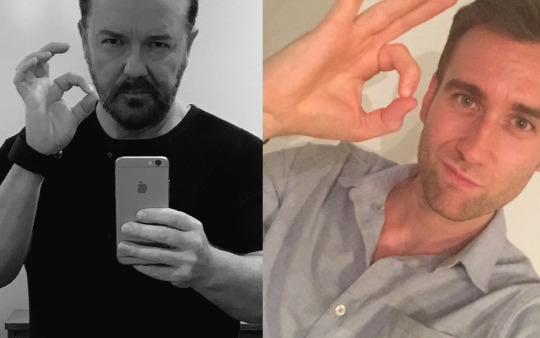
To fairly evaluate social media and health campaigns, we can contrast its effectiveness with the irony of using it or the double edged sword effect, if you like. Many studies have founds links between social media and mental illness, although this can be highly linked to societies behaviour rather than the media platform itself (Cottle, 2016). It could also be argued that “social media is a two-way street, and allows non-experts to share information just as rapidly as health agencies, if not more so” (Dosemagen, 2017), which incorporates rumours and misinformation which is harmful to the public.
It can be concluded that social media is a great tool to advance health campaigns, although great care must be taken by users when interpreting information from untrustworthy sources.
References:
Cottle, J 2016, ‘Facebook And Mental Health: Is Social Media Hurting Or Helping?’, Mental Help, Viewed on 16th May 2017 <https://www.mentalhelp.net/articles/facebook-and-mental-health-is-social-media-hurting-or-helping/>
Dosemagen, S 2017, ‘How Social Media Is Shaking Up Public Health and Healthcare’, Huffington Post, Viewed on the 15th of May 2017 <http://www.huffingtonpost.com/shannon-dosemagen-/how-social-media-is-shaki_b_9090102.html>
Weaver, J 2016, ‘More People Search for Health Online’, NBC News, Viewed on 15th May 2017 <http://www.nbcnews.com/id/3077086/t/more-people-search-health-online/>
0 notes
Text
Crowdsourcing and Social Media: 5
Crowdsourcing is technique used by media firms to effectively obtain information which can be text or multimedia, from a large quantity of people either from crowdsourcing platforms, such as Rappler, or designated people who have access to social media accounts for media firms. Rappler is a platform that was heavily used during the typhoon Yolanda which occurred in the Philippines, data was also collected by netizens when hash tagging #YolandaPH by many media firms (Capati, M. K. 2015).

In 2010, ABC News had chosen to crowdsource their information as part of its emergency broadcasting. There were many challenges faced by doing which, which including choosing the most accurate and enticing information pieces to use in their broadcasts. The ABC released a Flood Crisis Map, which was so popular is was inaccessible at a few stages due to excessive use. The Flood Crisis Map allowed for information to come though many sources such as texts, emails social media and online reports which was then moderated and assigned/published on the map. It also has a separate section where official information is received by official services which is not necessary in the moderation process. This can also be seen using BushFireConnect, which is the same concept, but focusing on bush fires.

(Picture from Middleton, S. 2011)
“What makes [crowdsourcing] effective is that it’s near instantaneous and it’s provided by people on the ground. It’s not an alternative to the official information sources that come from the SES and the police, but because they have a very strict and structured information management process, there is by necessity a lag before information trickles through that pipeline” – Maurits van der Vlugt
Advantages of Crowdsourcing:
Significant cost savings
Lag minimisation by large population of instant information
Anyone can join when using social media, allowing them to assist in the process of connecting information and being a part of something
Disadvantages of Crowdsourcing:
Dead weight members, wasted time moderating countless useless information
Paying more, does not mean increased quality in work as most of the work is conducted by amateurs�� (Floren, C 2012)
It can be seen that ABC’s crowdsourcing was successful in its outcome and aims, which were to receive and bounce information quicker through its large twitter account. The information was used in multiple channels, such as live news, crisis maps and simply used to inform social media users of the crisis which was rapidly dispersed within the sphere of the internet and television.
References:
Capati, M. K. 2015, ‘5 Crowdsourced News Platforms Shaping The Future of Journalism and Reporting’, Crowd Sourcing Week,Viewed on 1st May 2017 <http://crowdsourcingweek.com/blog/5-crowdsourced-news-platforms/>
Floren, C. 2012, ‘ The Advantages and Disadvantages of Using Crowdsourcing to Improve Your Ecommerce Business’, My Ecommerce, Viewed on 1st May 2017 <http://myecommerce.biz/blog/2012/07/the-advantages-and-disadvantages-of-using-crowdsourcing-to-improve-your-ecommerce-business/>
Middleton, S. 2011, ‘Mapping the Queensland Floods’, ABC Open, Viewed on 1st May 2017 <https://open.abc.net.au/explore/1643>
0 notes
Text
Social Media and Trolling: 4
Social media has been a tool which each year becomes increasingly accessible, efficient and popular. With around 2.34 billion people using social media worldwide (Statista, 2017), there are bound to be controversial issues relating to ethical, moral and allowed treatment of fellow digital citizens. Note that allowed, does not always equal ethical or moral.
This is where the issue lies and where 2 forms of negative participation occur. The first, Trolling, which is where a participant involves himself or creates and argument for the sole purpose of gaining a reaction from the receiver by hurling insults, extreme views or inflammatory comments over the internet (Wiki, 2017), which is legal. The other, is harassment. Harassment is considered more serious, which consists of constant annoyance, personal malice, prejudice and even the act of subjecting someone to intimidation by threat (Dictionary, 2017), which is illegal. A form of harassment, is cyber bullying, which is just bullying over the internet. The problems in determining between the 2, where intent is hardly black or white, as everything is open to interpretation.

Inherently, the internet is full of opinions and all well-presented ones should be considered! According to Ariel Bogle (2017), “Trolling allows malicious behavior to be set apart from acts we would strongly resist offline”, which is really true when you think about it. Would you go up to a person who would be considered a physical threat during an altercation and form an opinion that would knowingly offend them? Unlikely, and therefore trolling can be seen as a form of bullying, preying on the weak or only ‘prey’ when hidden.

As a society which in constantly evolving to control or eliminate negative behavior on social media, we have put systems or people in place to decrease trolling and harassment occurrences:
Norms on public available forums\publications usually have moderators whom are in charge of acting when trolling or harassment occurs. They can usually report, ban and remove the defendants or their posts. This is effective, but not bulletproof. Also, they are people and therefore perceive posts in their own way, which is sometimes a grey area.
National laws are set which safeguard people and are prosecutable if breached, although not all claims of harassment are reported, infact, studies show only 12% of people report it (Onlineharassment, 2017) and sometimes trolling can be mistakenly reported, not that trolling is ethical.
Educational campaigns are usually funded and set up by government funded organisations where the effects of cyber bullying are discussed to the school children, and where organisations such as ‘CyberBully Hotline’ exist.
In conclusion, the inherent problems are slowly being addressed but the only way to eliminate these problems completely are to ban social media, or have a world where each person believes in being a selfless individual who’s worth is in the community. Either are unlikely to happen, though (excluding communist countries).
References:
Statista 2017, ‘Statistics and Facts about Social Media Usage’, Statistica, Viewed on 24th April 2017 <https://www.statista.com/topics/1164/social-networks/>
Wikipedia 2017, ‘Internet Troll’, Wikipedia, Viewed on 24th April 2017 <https://en.wikipedia.org/wiki/Internet_troll>
Bogle, A 2017, ‘Why it’s Time to Stop Saying Trolling when it’s Actually Harassment’, Mashable, Viewed on 24th April 2017 <http://mashable.com/2017/01/09/stop-trolling-harassment-abuse/#OoklOAKc_mqV>
OnlineHarassmentData 2017, ‘The Rise of Online Harassment’, OnlineHarassmentData, Viewed on 24th April 2017 <http://onlineharassmentdata.org/?
0 notes
Photo




Zuma must fall! Are the words I heard this morning in my Pretoria home, being chanted loud and clear for the world to hear. Protesters are marching to the Union Buildings for the current President of South Africa to step down alongside with his presidency. A man who has continually failed and has truly and thoroughly (I have to be crude here) fucked the people within the nation. Jacob Zuma continues to exploit the pillars and principles of our nation for his personal needs and those close to him, from rape cases to Nkandla (the presidents homestead which he paid for with taxpayers money valued at over R200 million, converted equivalent to over $13 million). I have moved from a concerned citizen to a citizen who applying action to stop this man who is supposed to be a leader from continuing to horribly screw the people into further downfall. The government states that they are aware of protests that the people make, the force of action that is being used to have their qualms, frustrations and needs expressed.
The authority continues to state that they have become lax with dealing in issues, and that they need the wake up call. Why is it the duty of the citizens to force the government to remember the constitution, the policies they promised the people and the interests they have to uphold for the people? The current leadership has belittled the people that they must care the most for. The nation is running wild with corrupt ministers, judicial system, and most of all the supreme, the man who must rule with an iron fist, the president.
The nation is tired of having president Jacob Zuma standing on the shoulders of the nation to lift himself higher. The nation is tired of having to watch this man laugh when questions are asked and he diverts them. The nation is tired of a man who raises his middle finger to the public. South Africa has lost its funny bone, the public is exhausted we the citizens make jokes about the ridiculousness of how the country is run in the hope that there is still room for change. We are now tired of laughing with the president, we are now exhausted for the lack of interest this man shows in his country. Now it is time for us to forcefully take what we want from the future leaders to help create a better society for generations to come and instill long lasting good effects for the future. “May God bless you with anger and injustice at oppression…anger at exploitation and corruption,” Tutu prayed. This is about us taking back our country. We cannot stand by while our country is being rot by corruption.
Image source:ENCA
12 notes
·
View notes
Text
Social Media and Activism: 3
Social media has become a major tool in progressing activism/online activism and is used by thousands, if not millions, of activists or politicians to communicate a point.
Why is social media used as opposed to traditional communication methods?
Timely publication of a point
Larger Audience
Can make protesting/activism easier and more convenient as opposed to marching in hail, rain or shine.
Engagement and actual interaction is encouraged to create a ‘ snow ball’ effect within the movement, making it larger than ever
Can accumulate more participants when organising a protest due to accessibility and reach-ability
Social media is arguably the most effective way to initiate any sort of activism. It is even used when protesting/organising protests against corrupt government officials. Whether it be by organising an event, raising awareness by sharing a story with graphic content or by using ‘Hashtag Activism’, which has “the power to bring attention to and mobilize a large population. Petitions, protests, letters to politicians and those in power are disseminated through social media, but what brings attention to a movement or a hashtag is the high number of mentions of a hashtag, which is what brings it worldwide attention” (Sabina Khan-Ibarra, 2017). For example, the president of South Africa (Jacob Zuma) had removed a rather large number of cabinet members for unexplainable reasons which consequently led to a plummet in the native currency. The response of the public, having dealt with many unethical events revolving around the president before who has had hundreds of cases of corruption against him, were to post expressions followed by the #ZUMAMUSTFALL hashtag. The trend soon turned to protest.

This is a good example of Citizen Activism. Citizen activism is where a collection of protestors ensure that the state is held responsible for the needs of society (Henrik Bang. 2005). Before social media, many protests did not occur do to the narrow communication channels as opposed to today’s widespread content effected by virality on social media.
There are judgments made to this type of activism though, as with anything. Charlotte Robinson states ‘We continuously absorb social justice messages, but we don’t take the time to act upon them. This inaction is commonly referred to as “slacktivism”’ (Charlotte Robinson, 2014). The argument feeds on types a social media activism which mitigates at social media
In conclusion, I think social media is a great tool to raise awareness and form social justice groups although there is a fine line between a trend and movement which can come down to the nature and content of the participating activities involved. I believe social media should be used, but carefully, as opposing movements can be formed just as fast as others in a time where such discrepancy exists between opinions/values.
References:
Bang, Henrik. "Among everyday makers and expert citizens" Remaking governance: Peoples, politics and the public sphere(2005): 159-178
Khan-Ibarra, S 2015, ‘The Case for Social Media and Hashtag Activism’, The Huffington Post, January 13, Viewed on 10th April 2017
0 notes
Photo
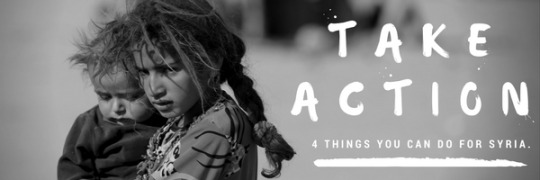
Take action - 4 things you can do for Syria
As the war in Syria enters its seventh year, many of us feel helpless. We hear stories about children such as Fares, a 6-year-old from Syria who has never seen a classroom in his life, and we wish there was something we could do.
“My name is Fares. I do not know how to read or write. I only know how to draw the sky, the sea and the sun.”
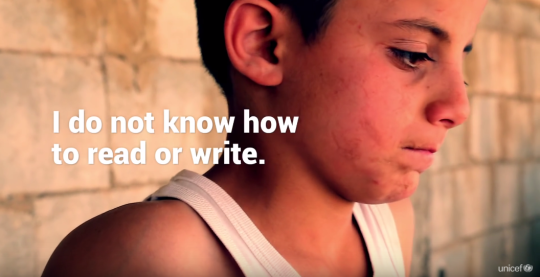
But we must not give up hope. Together, we can take action. Together, the Messengers of Humanity can show their solidarity with the Syrian people.
In the following weeks, we will send you powerful actions that you can take to make a difference for the people trapped in Syria’s conflict and for the people who had to flee and leave everything behind.
Remember, you are not alone! The UN and our partners in Syria are delivering aid to millions of civilians, trying their best to reach as many people as possible. And on 4 and 5 May, world leaders will come together in Brussels to discuss the future of Syria and to find a lasting political resolution.
Her are 4 actions you can take to support refugees & displaced people
1. Make sure that Syria is not forgotten – share on social media
UNICEF released this moving video of 10-year-old Ansam, a blind girl who was displaced by the violence in Syria. Her song is a message of hope to the world. Children such as Ansam are not giving up and neither should we. Please share!
Click here to tweet: Do you wish there was something you could do to help #Syria? Check out these 4 actions that you can take now http://bit.ly/4thingsyoucando
youtube
2. Encourage universities to offer scholarships for refugees
For refugee students, not being able to continue their studies is devastating. Help them by writing an e-mail or a letter to your own university or a college near you and ask them to support a refugee. You can also e-mail major universities in the USA, asking them to admit more refugees. Here is a handy template.
3. Support internally displaced people in Syria
We hear a lot about refugees who seek safety outside Syria, but more than six million Syrians are displaced within their own country. They are often forced to flee at very short notice and have to leave everything behind. Many of them find refuge with host families, but others have to stay in overcrowded shelters. As the conflict continues, they are struggling to find food and water and are in dire need of humanitarian aid. If you want to help internally displaced people in Syria, you can donate to the UN’s humanitarian fund in Syria. Your donation will provide emergency food, water, shelter, medicine and other life-saving assistance to those who need it most.
4. Help refugees to integrate into a new culture
Refugees often feel lonely and isolated when they try to restart their life in a new country. Could you see yourself mentoring a refugee family? Imagine teaching the kids your language or helping the parents figure out the public transport system. Even small gestures of friendship can mean a great deal! A quick Google search can show you which groups and local non-profits are active in your area and looking for volunteers.
That’s it for today! Stay tuned, because over the following weeks and months we’ll share more actions that you can take to make a difference.
10K notes
·
View notes
Text
Political engagement and Social Media: 2
Social media has become a means for communication from many different socio-cultural groups, networking many ideas and concepts through online participators. Online participants are people or entities who share content, debate and sometimes with the intention to spark social change (luts, Hoffman & Meckel, 2017). In recent years, it has been observed that social media is being used by politicians to gain attention from different groups of people (specifically younger) through interaction through vlogs, posts an images using social media platforms.
Social media is used by politicians to get more personal, involve humour and engage on another level compared to media releases and press conferences. This is known as ‘political participation’, further explained as actions which prompt a consequence, good or bad, while participating online (Verba et al., 1995: Voice and Equality)
Certain Politicians, depending on the wing, have pages which attract people who have similar views and thoughts on politics which creates publics. Publics are people who loosely share knowledge, similar content and social culture through engaging on social media (Mizoku Ito, 2008: 2-3,6). Publics can be connected through liking pages and applying hashtags to your posts. This can be described as ‘homophily’. Either side of America’s largest political parties have a centralised network seemingly based around the politician.

Political engagement in social media is important. There are hidden figures, analytic’s and other useful information collected from social media. Political parties can measure reach, engagement and positive and negative indicators which can be promoted (suggested posts)and used to influence social perceptions.
It might be argued, from a traditional point of view, that politicians on social media creates a sense of unprofessionalism, although in this day and age of digital networks it seems silly to not take advantage of it. Another issue is that these politicians are subject to scrutiny as their posts are not limited to their followers, which can be dangerous for their image.
Civic culture, which can be described as culture within society which accepts the political authority and partakes in civic duties (Wiki def.), can be unsettled by social media. The sphere of users is much larger now, and unrest can form when passionate publics unite. Social media also allows for better engagement though, so it seems as if there must be some sort of balancing act, but that’s what politicians have social media managers for, right?
1 note
·
View note
Text
Is Tumblr a blog or social media platform?
To discuss this, first we need to know what each of these terms mean and what makes them different.
A web blog or, can be a publication of a person thoughts or feelings on a regular basis which can be run and managed by either one or multiple people (Marketing terms, 2017). Examples of a few blogs includes: WordPress, Blogger and Medium. Blogs usually tend to be content centered.
Social media can be descried as a platform which has an objective of connecting people through digital means and interactions, creating communities for information sharing (Whatis.Techtarget, 2017). Examples of social media platforms include: Facebook, Twitter and LinkedIn. Social media tends to be personality centered.
The main differentiation between these if the intention of the publication and type of communities. When using social media, you are creating a profile which can be manipulated, although it is expected to be a representation of you and certain personal aspects of your life. A blog may contain a profile, but can easily be anonymous or a completely designed to enhance the objective of the blog which may not be related to you at all. Blogs also have their own URL or web page which social media accounts do not.
Even though Blogs and Social Media sites gave similar affordances, they are different.
Other differences include the fact that social media platforms often have character limits which inhibit the writer’s ability to have long write-ups, such as Twitter. Blogs tend to have no limit or very large limits to allow for very detailed and lengthy posts.
Blogging can create a stronger community through continuous publications which are isolated to the blog itself with no competition. Social media on the other hand, attracts a much larger audience which creates a much larger spectrum for competition as millions of posts are being uploaded simultaneously (marcguberti, 2017).

I believe that Tumblr is a micro blogging site that tends to be more of a social media platform as opposed to a blogging site. It has features such as sharing, re-blogging or liking. These features are similar to Twitter’s features, although Twitter has a couple more. The most effective platform would be one which integrates blogging and social media, which is evident with Tumblr as it it personality and content centered. Tumblr seems to have publics which are much stronger than those of social media, for example, when starting a Tumblr, it invites you to choose subjects/topics that you are interested in to form and connect your profile to certain communities/publics. Tumblr also maintains over 500 million monthly users, which therefore gives it the trait of being social media.
References:
Whatis.techtarget.com. (2017). Cite a Website - Cite This For Me. [online] Available at: http://whatis.techtarget.com/definition/social-media [Accessed 29 Mar. 2017].
Marketing Terms. (2017). What is a Blog? - Definition & Information. [online] Available at: http://www.marketingterms.com/dictionary/blog/ [Accessed 29 Mar. 2017].
Guberti, M. (2017). The Difference Between Blogging And Social Media | Marc's Blog. [online] Marc's Blog. Available at: http://marcguberti.com/2013/07/the-difference-between-blogging-and-social-media/ [Accessed 29 Mar. 2017].
0 notes
Text
Disclaimer
“Portions of this site and the works within it are being produced with the intention of critique and/or educational use under Australia’s ‘fair dealing’ exceptions to copyright (Section 40 & 41). However, if you feel your IP is being infringed, please contact my service provider (tumblr) with the appropriate DMCA requests, as I, the single author take full responsibility for the content of this site.”
0 notes